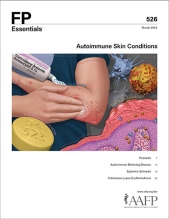
This clinical content conforms to AAFP criteria for CME.
Psoriasis is a chronic, inflammatory skin condition with significant effect on quality of life. It affects 3.2% of the United States population. Psoriasis is caused by an interaction between genetic and environmental triggers. Associated conditions include depression, increased cardiovascular risk, hypertension, hyperlipidemia, diabetes, nonalcoholic fatty liver disease, Crohn disease, ulcerative colitis, celiac disease, nonmelanoma skin cancers, and lymphoma. Several clinical variants exist, including chronic plaque, guttate, pustular, inverse, and erythrodermic psoriasis. Lifestyle modification and topical therapies, such as emollients, coal tar, topical corticosteroids, vitamin D analogues, and calcineurin inhibitors, are used for limited disease. More severe psoriasis may require systemic therapy with oral or biologic therapy. Individualized management of psoriasis may involve different combinations of treatments. Counseling patients about associated comorbidities is essential.
Case 1. AB is a 33-year-old patient with a history of depression and hypertension who comes to your office for evaluation of a skin rash that has been getting worse over the past 5 years. The rash is thick with well-defined erythematous plaques and silvery scale on her scalp, knees, elbows, abdomen around the umbilicus, and thighs.
Epidemiology and Disease Burden
Subscribe
From $350- Immediate, unlimited access to FP Essentials content
- 60 CME credits/year
- AAFP app access
- Print delivery available
Edition Access
$44- Immediate, unlimited access to this edition's content
- 5 CME credits
- AAFP app access
- Print delivery available
